Explore the Best Tourist Attractions in the UAE
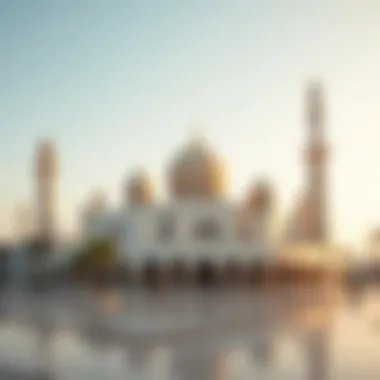

Intro
When you look at the United Arab Emirates, a blend of robust modernity and deep-rooted tradition presents itself like a dazzling mirage. With seven emirates, each flaunting its own character, a traveler finds a striking array of attractions that beckon exploration. From the towering heights of the Burj Khalifa in Dubai to the tranquil shores of Fujairah, this region offers something for every wanderer.
Not just about luxury shopping and high-tech architecture, the UAE also offers rich cultural tapestries through various museums, bustling markets, and historical sites. As we embark on this journey, we'll navigate iconic landmarks, delve into cultural experiences, and unveil natural wonders that define the UAE's tourism landscape.
This guide will serve as a roadmap, detailing popular spots as well as hidden gems, providing diverse activities that satisfy both residents and jet-setters. The allure of the UAE is not only found in what can be bought but also in what can be learned and experienced. The following sections will further dissect these captivating attractions and their historical nuances, appealing to both savvy investors looking for opportunities and casual visitors seeking a memorable getaway.
Overview of Tourism in the United Arab Emirates
Tourism in the United Arab Emirates (UAE) has evolved into a cornerstone of the nation's economy and culture. A blend of modernity and tradition, the UAE presents a unique narrative to the world, drawing millions of visitors each year. The allure lies not just in the gleaming skyscrapers or luxury malls, but also in the rich tapestry of heritage, art, and diverse experiences that cater to both the affluent and the adventurous.
Economic Impact of Tourism
The economic ramifications of tourism in the UAE are significant. This sector not only contributes to the GDP but also creates a plethora of jobs across various industries such as hospitality, retail, and transportation. In 2019, before the impact of global events shook the travel landscape, the UAE was witnessing annual tourism revenue in the billions of dollars. Cities like Dubai and Abu Dhabi were rapidly expanding their infrastructures, with new hotels, attractions, and transport links appearing like wildfire.
Moreover, a considerable part of the government's strategic vision focuses on tourism. The UAE has invested heavily in diversifying its economy, reducing dependence on oil revenues. Tourism plays a pivotal role in this endeavor. The government has been promoting various initiatives, such as the introduction of long-term visas, aimed at attracting not just tourists but also skilled professionals and investors.
"The tourism industry is an essential thread woven into the UAE's economic fabric, enhancing sustainability and growth."
Tourism Trends in Recent Years
In recent years, the tourism landscape in the UAE has shifted dramatically. One notable trend is the rise of eco-tourism and sustainable travel. With increasing global awareness around environmental issues, travelers are seeking experiences that are not only enjoyable but also respectful of local cultures and nature.
This shift has led to the emergence of initiatives that support responsible tourism, such as community-based projects and conservation efforts. For instance, new resorts and attractions are often built with sustainable practices in mind, engaging local communities to present authentic cultural experiences.
Additionally, technology plays a crucial role in shaping today's travel trends in the UAE. From virtual reality experiences in museums to smartphone apps that enhance visitors' journeys, technology-driven innovations are redefining the travel experience. Customizable travel packages and smart transport options are increasingly popular, catering to this tech-savvy generation of tourists.
Tourism trends also reflect a shift towards experiential travel. Visitors no longer just wish to sightsee; they seek to immerse themselves in the local culture. So, activities such as cooking classes, cultural workshops, and heritage festivals have gained popularity, allowing tourists to connect with the rich traditions of the UAE.
Dubai: The Thriving Metropolis
Dubai stands as a shining example of what vision, ambition, and investment can accomplish in a region that was once largely desert. This bustling metropolis isn't just a collection of impressive buildings and high-end malls; it's a vibrant hub that holds immense significance for both tourists and investors alike. The city’s strategic location, incredible infrastructure, and dynamic lifestyle make it a magnet for visitors who seek luxury, culture, and adventure in one package.
Moreover, Dubai’s ability to reinvent itself continually is noteworthy. Each year, new attractions emerge, showcasing the UAE's commitment to enhancing the tourist experience. This relentless development is also mirrored in its booming real estate market, which attracts buyers, renters, and developers from all corners of the globe. As we delve deeper into the key attractions within the city, it’s essential to consider their multifaceted appeal: cultural richness, architectural beauty, and leisure opportunities.
Burj Khalifa: A Skyscraper of Records
Standing tall at a staggering height of 828 meters, the Burj Khalifa is more than just the tallest building in the world; it symbolizes Dubai's ambitious spirit. Completed in 2010, this architectural masterpiece draws millions of visitors each year who flock to its observation decks to gaze upon panoramic vistas of the city and the surrounding desert.
The tower is not simply about height; its design incorporates elements of traditional Islamic architecture intertwined with modern aesthetics. Visitors also have the opportunity to explore the At the Top, Burj Khalifa experience, which offers insights into the building's intricate engineering and design details. The Burj Khalifa plays a crucial role in the city’s tourism, acting as a focal point around which many attractions, such as the Dubai Fountain and the Dubai Mall, revolve.
"The Burj Khalifa isn’t just a landmark; it’s the heartbeat of Dubai, pulsating with the energy of thousands every day."
The Dubai Mall: A Shopper’s Paradise
Adjacent to the Burj Khalifa, the Dubai Mall is a retail giant that encompasses more than just shops. Spanning over 1.1 million square meters, it offers a myriad of experiences beyond retail therapy, from an aquarium to an indoor ice rink. This mall isn’t merely a place to spend money; it’s an entertainment complex that caters to all visitors, making it one of the most visited shopping destinations on the planet.
For investors and businesses, the Dubai Mall represents a flourishing ecosystem that supports various brands and local artisans. The foot traffic in this location is substantial, reflecting the mall's reputation as a premier destination. Its proximity to the area’s key attractions also enhances its importance in the tourism framework of the city.
Palm Jumeirah: A Marvel of Engineering
Palm Jumeirah is often touted as one of the most famous man-made islands globally, showcasing what human ingenuity can achieve. This palm-shaped island is a residential and leisure hub that boasts luxury hotels, beach clubs, and expansive villas. Walking along the boardwalk, visitors are treated to stunning views of the Dubai skyline against the shimmering waters of the Arabian Gulf.
From an investment standpoint, Palm Jumeirah offers unique opportunities for those looking to buy or rent property in a highly sought-after location. Its appeal lies not just in its luxurious lifestyle but also in the potential for high returns, given its status as a global tourist attraction. As the island continues to attract high-profile projects, it solidifies its place in the UAE’s ambitious vision for tourism and development.
As we examine these attractions, it’s clear that Dubai has woven a rich tapestry of experiences that encapsulate its identity. The blend of modernity and tradition offers something for everyone, whether they are looking to indulge in luxury, explore cultural roots, or engage in thrilling adventures. Dubai's landscape continues to evolve, promising an enticing future for both visitors and investors.
Abu Dhabi: The Cultural Capital
Abu Dhabi stands tall as the cultural heart of the United Arab Emirates, intertwining modernity with a rich historical narrative. It serves as a vibrant hub, not just for tourists, but also for investors and artists. The importance of Abu Dhabi in the broader context of UAE tourism cannot be overstated; this city encapsulates the essence of Arab heritage while embracing contemporary art and architectural feats.
Culturally, Abu Dhabi has invested heavily in positioning itself as a global art capital. The significant growth in cultural institutions and public art initiatives has put the emirate on the map for art enthusiasts and investors alike. Abu Dhabi's development is not merely about infrastructure; it's about creating spaces where culture thrives and history is not forgotten.
Sheikh Zayed Grand Mosque: An Architectural Gem
The Sheikh Zayed Grand Mosque stands as one of the most iconic landmarks of Abu Dhabi, attracting millions each year. It serves as a stunning testament to Islamic architecture, with a design that blends various cultural styles. Covering an area of over 30 acres, this mosque features 82 domes, more than 1,000 columns, and intricately designed floral patterns. The craftsmanship involved in its construction is nothing short of astounding, inviting both tourists and locals to engage in a deeper understanding of Islamic principles and art.
A visit to the mosque provides not just a glimpse into architectural grandeur, but also access to guided tours that educate visitors about the significance of this holy place. From the shimmering white marble to the golden accents, every angle of the Sheikh Zayed Grand Mosque offers a new perspective. It’s particularly enchanting at sunset when the colors of the sky reflect off its surfaces, presenting a sight worth savoring.
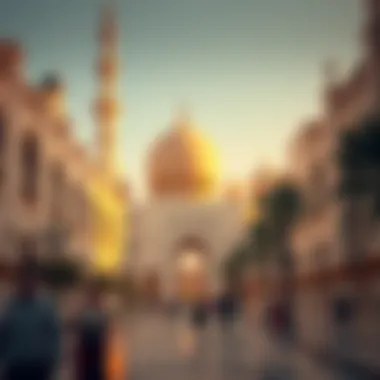
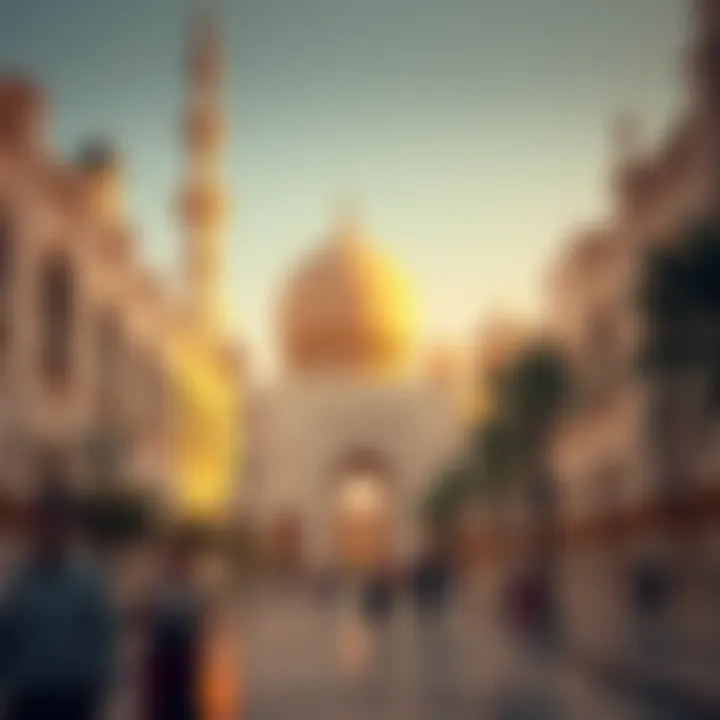
"A masterpiece of modern architecture, the Sheikh Zayed Grand Mosque is an invitation to explore the rich tapestry of Islamic culture."
Louvre Abu Dhabi: Where Art Meets Culture
Opened in 2017, the Louvre Abu Dhabi is another feather in the cap for the UAE’s cultural scene. Nested on Saadiyat Island, the museum embodies a vision to bridge eastern and western art, displaying artifacts and artworks that span centuries and cultures. This monumental structure, designed by renowned architect Jean Nouvel, is famous for its dome that allows sunlight to filter through in a manner reminiscent of a 'rain of light.'
The museum showcases works from around the world, emphasizing humanity’s shared heritage. Each exhibition offers a narrative that connects cultures in a meaningful way, enriching the understanding of art and history. The Louvre’s programming frequently includes temporary exhibitions that feature masterpieces on loan from prestigious international museums, adding to the dynamic nature of the space.
In facilitating cultural exchange, the Louvre Abu Dhabi also plays an essential role in nurturing local talent and encouraging artistic dialogue. For realtors, developers, and investors, such cultural landmarks signify a growing interest in the UAE as a destination for both leisure and investment, marking it as a locale of potential growth and opportunity.
Engaging with the cultural tapestry of Abu Dhabi provides an undeniable opportunity to explore not only historic depth but also economic potential. As travelers and investors flock to this unique convergence of tradition and modernity, Abu Dhabi certainly secures its position as the cultural capital of the UAE.
Sharjah: The Arts Hub
Sharjah stands out as a beacon of art and culture in the United Arab Emirates. It represents a unique blend of tradition and modernity, captivating visitors with its commitment to preserving heritage while promoting contemporary artistic expressions. With its extensive array of galleries, museums, and cultural activities, Sharjah offers a diverse experience that appeals not just to art aficionados but to tourists seeking a deeper understanding of Emirati culture. The emirate is home to many key institutions and events that articulate the rich narrative of the region, thus solidifying its reputation as a vital cultural hub.
Sharjah Art Museum: A Cultural Repository
At the heart of Sharjah's art scene lies the Sharjah Art Museum, a notable institution that showcases both local and international artists. Opened in 1997, the museum has a diverse collection that ranges from contemporary works to traditional art forms. The exhibitions often feature pieces that reflect the cultural narratives of the Arab world, making it an essential stop for anyone interested in understanding the artistic landscape of the region.
Visitors will find a rotating selection of temporary exhibitions that celebrate various artistic movements, alongside a permanent collection that spans many decades. The museum not only serves as a gallery but also hosts workshops, lectures, and community events that engage both residents and visitors in the arts. This interactive approach highlights the museum’s commitment to fostering creativity and dialogue among diverse audiences.
Moreover, the museum features impressive architecture, enhancing the overall aesthetic experience. Art lovers can take a leisurely stroll through its spacious halls, which also provide spectacular views of the surrounding area, further connecting the art pieces with the landscape of Sharjah.
Sharjah Heritage Area: A Walk Through History
Diving into the past, the Sharjah Heritage Area offers a unique journey through the history and traditions of the Emirates. The district is a well-preserved treasure trove, featuring traditional wind-tower architecture, local craft shops, and cultural sites that tell the story of Sharjah's evolution. Walking through the narrow streets, visitors can experience the ambiance that reflects the life of the Emirati people from earlier times.
Several key sites within the Heritage Area include the Al Hisn Fort, which has stood as a symbol of Sharjah’s history, and the Sharjah Arts Square, where art installations and cultural events take place, encouraging interaction among the community.
"Investors and developers should consider the cultural significance of Sharjah and its potential to attract tourism and local engagement through its artistic initiatives."
The vibrant atmosphere pulsated with rich traditions makes the Heritage Area an ideal engagement point for those who appreciate history and art alike. Visitors can enjoy local performances, taste traditional cuisine at nearby cafes, and witness artisans at work, all of which provide a snapshot of the UAE's cultural heritage.
Ajman and Fujairah: Serene Escapes
Ajman and Fujairah, two tranquil yet captivating emirates of the UAE, offer a refreshing escape from the bustling urban life dictated by cities like Dubai and Abu Dhabi. While not typically highlighted in conventional travel brochures, they present distinct experiences that attract anyone longing for peace amidst stunning natural beauty and historical richness. This section explores why Ajman and Fujairah deserve more attention as ideal locations for a break and their unique tourist attractions that cater to a variety of interests.
Ajman boasts the smallest land area among the emirates yet provides a warm atmosphere modestly decorated with cultural treasures. In contrast, Fujairah, sitting on the Gulf of Oman, is endowed with breathtaking landscapes characterized by its mountainous terrain and coastlines. Together, these emirates harmonize leisure and history, making them a perfect retreat that assures relaxation and discovery.
Ajman Beach: A Relaxing Retreat
When wandering around Ajman, one cannot miss the alluring Ajman Beach. This stretch of golden sand laced with azure waters forms a captivating scene where locals come to unwind and tourists seek refuge from the fast pace of modern life. The beach provides an ideal setting for soaking up the sun, whether lounging on the soft sand or enjoying water activities that include jet skiing and banana boat rides.
Moreover, Ajman Beach stands out not just for its appealing scenery but also for its amenities. Numerous cafes and eateries line the shore, offering delicious local dishes and refreshing beverages that satisfy one's appetite after a sun-soaked day. Visitors can relish traditional seafood dishes while enjoying the salty breeze and stunning views.
The relaxed ambiance is perfect for a family day out or a peaceful getaway with friends. For those who enjoy a bit of exercise, there’s always the option to engage in beach volleyball or go for a leisurely jog along the water's edge.
Fujairah Fort: Echoes of the Past
While Ajman tends to capture the soul of leisure, Fujairah fort is where history enthusiasts find a treasure trove of intrigue. This fort, a remarkable testament to the region's rich past, stands proudly against the backdrop of the Hajjar Mountains. Built in the 16th century, the site reflects the traditional architecture of the time and was once vital for protection against invasions.
Exploring Fujairah Fort offers visitors a glimpse into the past. Guests can wander through its ancient corridors and towers, appreciating the fine masonry that has withstood the test of time. It’s an outstanding spot for photography, particularly at sunset when the golden light bathes the fort, enhancing its already captivating allure.
In addition, the nearby Fujairah Museum complements the fort well, showcasing artifacts that narrate the emirate's historical timeline. From pottery to weaponry, the exhibits provide context and depth, ensuring an enriching experience for visitors.
As you walk through Ajman’s serene beach and Fujairah's captivating fort, it quickly becomes clear that these destinations offer more than just relaxation; they embody the charm of the UAE’s heritage, waiting to be discovered by those willing to explore its less-traveled paths.
In summary, Ajman and Fujairah serve as reminders that serene escapes don’t need to be flashy and crowded; they can also be peaceful, steeped in history, and captivating.
These emirates provide a perfect balance of relaxation and cultural immersion, making them ideal for discerning travelers and investors interested in more than just the glitz and glamour.
Ras Al Khaimah: Adventure Awaits
Ras Al Khaimah, often overlooked in favor of its flashier neighbors, is a gem that invites adventure enthusiasts and history buffs alike. With its unique landscapes that range from sandy beaches to rugged mountains, it presents a compelling destination for visitors who crave both thrilling activities and cultural experiences. As the northernmost emirate, Ras Al Khaimah offers a landscape rich in history and natural beauty, making it worth a spot on any travel itinerary within the UAE.
Jebel Jais: The UAE's Highest Peak
Standing tall in the Hajar Mountains at an altitude of 1,934 meters, Jebel Jais is not only the highest peak in the United Arab Emirates but also a playground for adventure seekers. Here, you can experience the longest zip line in the world, soaring at speeds that will make your heart race. The views from the summit are simply breathtaking, showcasing the vast expanses of desert and mountains that stretch out below. For those who prefer a more leisurely pace, there are numerous hiking trails ranging from simple strolls to challenging treks, allowing everyone to enjoy the majestic scenery.
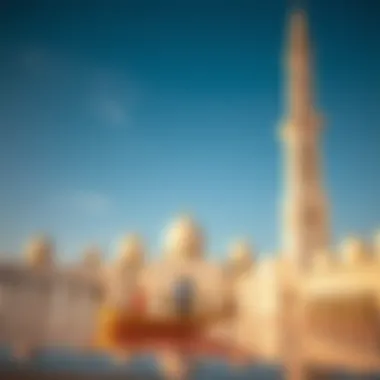
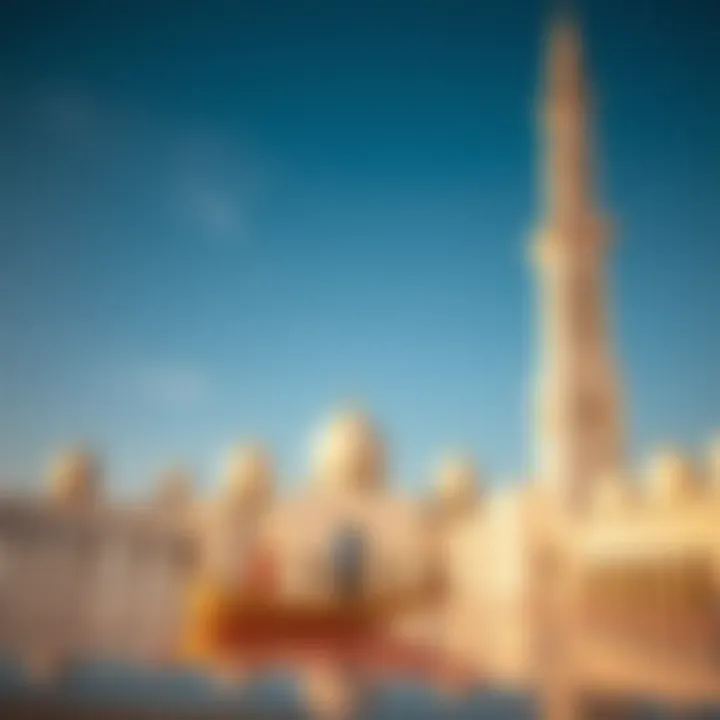
- Thrill-seekers can engage in:
- Zip-lining from peak to peak.
- Mountain biking on daring descents.
- Rock climbing for the truly adventurous.
Jebel Jais is not just a place for adrenaline, though. At night, the clear skies offer fantastic stargazing opportunities, a perfect antidote to the hustle and bustle of city life. Just bring along a blanket, and lie back to marvel at the tapestry of stars above.
Historic Sites: Al Hamra Village
Al Hamra Village is a window into Ras Al Khaimah's rich heritage, preserving traditional Emirati architecture and culture. Wandering through its narrow alleyways, you can glimpse life as it was decades ago. The village features restored buildings that date back to the 16th century, palm-frond houses, and the stunning Al Hamra Fort, which was once a stronghold against invaders.
Visiting Al Hamra offers a unique blend of leisure and learning. You can:
- Explore historic structures such as the Al Hamra Fort.
- Visit local markets where artisans showcase their crafts.
- Enjoy leisurely meals in restaurants that serve traditional Emirati dishes, allowing you to taste a piece of history.
"Al Hamra Village is like stepping back in time, where every stone tells a story."
Um Al-Quwain: Undiscovered Shores
Um Al-Quwain, often overshadowed by its more glamorous neighbors, holds a unique allure that's gradually capturing the attention of adventurous travelers. This emirate is characterized by its untouched landscapes, tranquil beaches, and rich cultural heritage, making it a hidden treasure along the United Arab Emirates' coastline. Here, visitors can find an authentic experience far removed from the hustle and bustle of modern city life.
The relevance of Um Al-Quwain in this discourse on tourist attractions can't be overstated. It offers a chance to explore not just natural beauty but also historical depth that resonates with both locals and visitors alike. Many people are now looking for off-the-beaten-path destinations, and Um Al-Quwain caters to these desires perfectly. Its serene environment provides a refreshing contrast to more crowded hotspots, enabling a deeper connection with both nature and history.
Beach Activities and Marine Life
Um Al-Quwain's coastline boasts some of the most pristine beaches in the UAE, where golden sands meet clear blue waters. Visitors can indulge in a myriad of beach activities, from kayaking to kite surfing, providing an exhilarating escape into the water. The shallow lagoons here are particularly suitable for families who might want a safe space for their children to enjoy the marine environment.
Marine life is exceptionally vibrant in these waters. Travelers can embark on a snorkeling adventure to witness colorful fish darting amongst coral formations. Birdwatchers will also find their share of excitement as the emirate is home to various species, including flamingos that flock to the area during certain times of the year.
To appreciate these sparkling waters:
- Try paddleboarding for a unique perspective of the serene environment.
- Engage in fishing trips that not only yield a rewarding catch but also allow one to soak in the calm of the sea.
- Join a boat tour that can lead to mesmerizing views of the coastline and perhaps even a chance to spot dolphins.
"Um Al-Quwain’s beaches serve as a canvas of charm, painting a picture of tranquility that travelers come to chase, far away from the archetypal attractions."
Heritage Sites: The Old Town
The old town of Um Al-Quwain peels back the layers of modernization to reveal its historical significance. This part of the emirate is rich in cultural heritage, evident in its architecture and the preserved sites that tell stories of a bygone era. A stroll through the old town can feel like stepping into a historical narrative complemented by the raw beauty of the area.
Key heritage attractions include:
- The Fort of Um Al-Quwain, offering insights into the region’s history as a former stronghold.
- The Museum, showcasing artifacts and exhibits that chronicle the emirate's evolution.
- Traditional buildings and souks, where local crafts and goods reflect the rich culture and artisan skills of the area.
Visitors have a chance to learn about traditional emirate life while enjoying beautifully restored sites that foster a greater appreciation for the past. These experiences allow one to connect with the local community, encouraging a sense of unity and understanding of the UAE's heritage.
The old town stands as a testament to the belief that sometimes the most engaging experiences come from exploring the quiet and unexplored pockets of a region, where every corner has a story to tell.
Natural Wonders of the UAE
The United Arab Emirates is not just characterized by its dazzling urban landscapes but also harbors breathtaking natural wonders that are equally worth exploring. These landscapes range from serene oases to rugged mountains. Each site provides a unique glimpse into the natural charm and diversity of the region. Through these natural attractions, tourists and residents alike can connect with the environment and discover the underlying beauty that defines the nation's geography.
Natural wonders like Liwa Oasis and Hatta are integral to understanding the UAE’s ecological balance and heritage. They offer respite from the bustling city life and invite visitors to engage with nature in a tranquil setting. Furthermore, these locations serve as prime examples of how natural beauty can coexist with development, making them appealing spots for relaxation, adventure, or educational pursuits.
The Liwa Oasis: A Desert Haven
Liwa Oasis stands as an impressive testament to life thriving in an arid region. Characterized by its endless expanses of golden sand dunes, some of which soar over 150 meters in height, this oasis showcases nature's resilience. The allure of Liwa lies not just in its dramatic landscapes but also in its historical significance as a trade route and a cultural hub.
Visitors to Liwa can engage in numerous activities that allow them to experience the desert's spirit:
- Dune Bashing: A thrilling way to explore the vast terrain in 4x4 vehicles.
- Camel Rides: These traditional means of transport provide a slower-paced exploration of the dunes.
- Star Gazing: Far from the city's lights, the night sky in Liwa offers breathtaking views of constellations that are often lost in urban areas.
The oasis also harbors date farms, representing the local economy, and showcasing traditional methods of agriculture. Travelers gain insight into historical practices, offering a remarkable juxtaposition to modern life in the UAE.
"Liwa Oasis is more than just a beautiful sight; it embodies the enduring spirit of survival in the desert."
Hatta: Mountains and Lakes
Nestled within the Hajar Mountains, Hatta is a unique destination that breaks the stereotype of the UAE being merely a desert nation. This mountainous enclave is known for its stunning landscapes, turquoise lakes, and opportunities for adventure. The highlighted activities here warmly call to those who enjoy both serenity and adrenaline.
Visitors can engage with Hatta’s offerings in various ways:
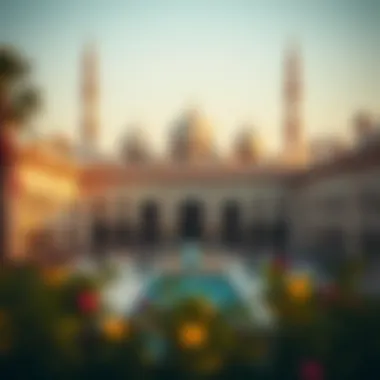
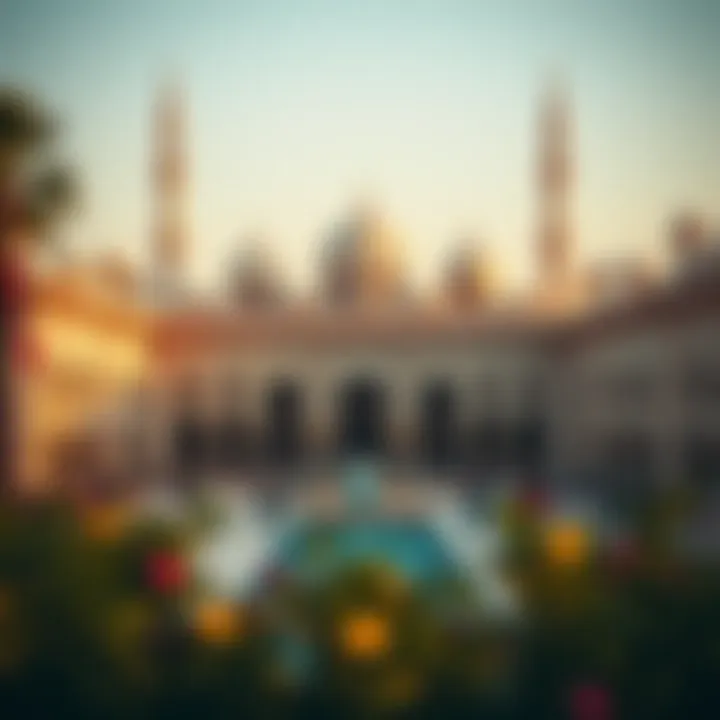
- Kayaking: The calm waters of Hatta Dam provide an ideal setting for kayaking amidst spectacular mountainous backdrops.
- Hiking Trails: Numerous trails ranging from easy walks to challenging hikes attract nature enthusiasts of all skill levels, presenting stunning panoramic views.
- Cultural Heritage: Hatta is home to traditional stone houses that reflect the region’s history and architecture, providing a deep dive into the local culture.
Moreover, Hatta serves as an ecotourism shining example, helping to conserve the natural environment while allowing visitors to immerse themselves in the beauty around them. This balance of recreation and preservation is increasingly significant in discussions around sustainable tourism.
In summary, the natural wonders of the UAE not only showcase its geographical diversity but also offer enriching experiences that foster a connection to the land. Locations like Liwa Oasis and Hatta underline nature’s dual role as a source of enjoyment and a vital part of the cultural heritage, making them must-visit attractions for anyone looking to truly appreciate what the UAE has to offer.
Cultural Experiences
Cultural experiences play a pivotal role in immersing travelers in the rich heritage and traditions of the United Arab Emirates. This section emphasizes the significance of understanding the cultural fabrics that define the UAE, highlighting the myriad of experiences from culinary adventures to vibrant festivals. These experiences not only enhance one's stay but also foster a deeper appreciation for the nation’s history and evolution from a group of fishing villages to a global hub of commerce and tourism. Through sharing meals, participating in traditional celebrations, and engaging with local art, visitors are offered a pathway to connect with the spirit of the UAE that goes beyond its architectural marvels.
Arabian Cuisine: A Culinary Journey
The culinary landscape of the UAE is as diverse as its people. Arabian cuisine is a fusion of flavors and influences, representing both regional and global touches. Meals here are more than just food; they embody hospitality and tradition.
- Emirati Dishes: Visitors should not miss out on trying Al Harees, a dish made from cracked wheat and meat that’s simmered for hours, or Machboos, a popular spiced rice dish that often features seafood or meat. These dishes reflect deep-rooted traditions that stem from the UAE's Bedouin heritage.
- Sweets and Treats: Don't forget to sample Baklava, with its layers of pastry filled with nuts and honey, or Knafeh, a dessert made with cheese and soaked in syrup. These delicacies showcase the region's penchant for sweetness, a fitting end to a savory feast.
Food in the UAE is often enjoyed communally, and sharing meals around a large platter encourages bonding and conversation among guests, embodying the essence of Arabian hospitality. This practice not only satiates hunger but also strengthens social connections.
Traditional Festivals: A Taste of Heritage
Festivals in the UAE offer a vibrant glimpse into the country’s deep cultural roots. Celebrations like Eid al-Fitr and Eid al-Adha showcase the country’s Islamic heritage, marked by prayers and feasts that unite families and communities.
- National Day: Celebrated on December 2nd, this day marks the formation of the UAE in 1971. The festivities include parades, fireworks, and cultural exhibitions that reflect the pride of both locals and residents.
- Shop Qatar and Abu Dhabi Festival: These events spotlight local talents and international artists alike, bridging cultures through art, music, and performances. Visitors can expect vibrant atmospheres filled with creativity.
Engaging in these festivals allows tourists to witness the UAE's passion for tradition and cultural expression, building a genuine connection with the land and its people.
By indulging in Arabian cuisine and participating in traditional festivals, travelers enrich their understanding of the UAE’s cultural landscape. Such experiences not only provide unforgettable memories but also foster respect and appreciation for the region's heritage.
Practical Information for Travelers
When venturing into the United Arab Emirates, knowing the essentials can significantly enhance your experience. The UAE is a mosaic of cultures, and being well-informed can save you both time and hassle. This section explores vital aspects for travelers such as visa requirements and local transport options, crucial in navigating this vibrant region.
Visa Requirements and Documentation
Understanding the visa requirements is the first step for any traveler intending to visit the UAE. The visa applications vary depending on the nationality, purpose of visit, and length of stay. Most visitors from Western countries can enjoy a visa-free stay for 30 days upon arrival, but it's always wise to double-check before you pack your bags.
Key Points to Consider:
- Visa on Arrival: Many nationalities qualify for this option, allowing a simple process at the airport. It is advisable to carry your passport, hotel reservation, and return ticket.
- Pre-departure Visas: Certain countries require visas in advance. You can apply online or through the nearest UAE embassy. Often, a local sponsor might be needed, especially for longer stays.
- Document Preparation: Ensure your passport is valid for at least six months beyond your planned departure date from the UAE. Having printed copies of your itinerary and passport may also prove handy.
“The more you prepare, the smoother your journey will be.”
For more detailed information on visa policies, refer to uae.embassy.gov.
Local Transportation Options
Once you've landed, understanding your transportation options can make the world of difference. The UAE has modern and efficient transport systems, yet knowing which option fits your needs best is prudent.
Available Transport Modes:
- Metro Systems: Cities like Dubai and Abu Dhabi feature extensive metro networks that are clean, safe, and widely used. The Dubai Metro, specifically, connects major attractions and is easy to navigate.
- Taxis and Ride-Sharing: Taxis are plentiful and reasonably priced, compared to other global destinations. Many travelers also prefer apps like Uber or Careem, which offer a convenient, cashless experience.
- Buses: The bus service in big cities is reliable. While the routes may be complex, they provide a cost-effective way to explore. Make sure to check the RTA website for specific routes and timings.
- Car Rentals: If flexibility is your aim, consider renting a car. Numerous international rental agencies operate in the UAE, providing various options for all budgets. Just be mindful of local driving laws, as they can differ significantly from other countries.
In summation, familiarizing yourself with visa requirements and transportation options can pave the way for a smooth travel experience. With a little research and preparation, you'll find that the UAE's attractions are more accessible than ever.
Future of Tourism in the UAE
The prospect of tourism in the United Arab Emirates stands as a beacon of development and potential. As a nation that balances deep-rooted traditions with soaring aspirations, the UAE recognizes that tourism is not just a revenue generator but a vital part of its global identity. The future beckons with promises of growth, innovation, and sustainability—elements that cater to a wide array of tourists while preparing to meet the shifts in consumer preferences.
Local governments, businesses, and communities are realizing the importance of adapting to changing travel behaviors and environmental impacts. Investments in sustainable tourism, alongside infrastructural developments, play a crucial role in positioning the UAE prominently on the international tourism map. These efforts serve not just to attract tourists but also to enrich the local culture and economy, creating a win-win scenario for residents and visitors alike.
A significant focus on responsible tourism ensures that the exquisite landscapes and the rich cultural tapestry of the UAE are preserved for future generations. By emphasizing local experiences and heritage, tourist attractions will more than likely enhance their value and authenticity, making them stand out.
"In a world where environmental concerns are paramount, sustainable tourism is no longer an option; it's a necessity for the future of travel."
Sustainable Tourism Initiatives
The drive for sustainable tourism in the UAE is evidenced by a series of initiatives aimed at preserving the natural environment and local cultures. The UAE government is actively promoting policies that encourage eco-friendly practices across various sectors, especially in tourism.
Sustainable tourism isn't just about minimizing harm; it's about maximizing benefits. Here are some critical initiatives underway:
- Green Building Standards: Many hotels and resorts are adopting sustainable practices such as energy-efficient structures and water-saving technologies, aligning with the UAE's commitment to reducing its carbon footprint.
- Wildlife Conservation: Initiatives in places like the Sir Bani Yas Island, where visitors can experience nature reserves while contributing to wildlife rehabilitation efforts, ensure the protection of endangered species and their habitats.
- Local Community Engagement: By integrating local culture into tourist experiences, businesses strengthen community ties, enabling tourists to better understand and appreciate the traditions that have shaped the UAE.
Investors and businesses that prioritize these initiatives not only enhance their appeal but also build a brand that resonates with a socially aware consumer base looking for authentic experiences.
Innovative Projects on the Horizon
As the UAE eyes the future, innovative projects are springing up that aim to cater to the adventurous spirit of modern travelers while embracing technological advancements. The goal is to offer unparalleled experiences that blend culture and cutting-edge technology. Several key projects are emerging:
- The Museum of the Future in Dubai: This architectural marvel is not just a building but a vision of what lies ahead, showcasing advancements in technology and the new paradigms of tourism.
- Hyperloop Transportation: As part of making travel seamless, the UAE is looking to integrate Hyperloop transport systems, promising connectivity that would shorten travel times between cities dramatically.
- Smart Tourism Solutions: Implementing smart technologies, such as augmented reality tours and mobile-based interactive experiences, allows travelers to engage with their surroundings in novel ways.











